Parish Project 2006
Kagando Hospital, Uganda
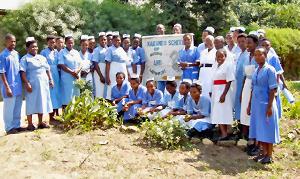 Our Parish Project for 2006 is the Kagando Hospital and Rural Development Center (KARUDEC) in the Kasese district in southwestern Uganda.
Our Parish Project for 2006 is the Kagando Hospital and Rural Development Center (KARUDEC) in the Kasese district in southwestern Uganda.
KARUDEC was founded by the Anglican Church of Uganda to improve the physical and spiritual well-being of the poor and disadvantaged people in the district. The hospital community programs serve all who are in need, regardless of ethnic background or religious belief.
Becca's Letter from Uganda
Each month Rebecca Baldock, who is working as a physiotherapist and missionary at Kagando Hospital, sends a letter back about life in Uganda.
- December 2007
- May 2007
- April 2007
- December 2006
- November 2006
- October 2006
- August 2006
- June 2006
- May 2006
- March 2006
- February 2006
- January 2006
Associated Events
There will be a number of associated events happening throughout the year to raise money for the Parish Project. Keep an eye on the Diary page.
The following events have so far been confirmed. If you would like to volunteer to help at one of them, please contact Gordon Gray.
- April 2006
- Friday 21st - Beetle Drive at Edlesborough Memorial Hall, at 7pm. Adults £2, Children £1, tickets available from Sally Taylor.
- Saturday 29th - Coffee Morning at All Saints, Dagnall, 10am until noon.
- June 2006
- Sunday 11th - Open Gardens Exhibition: for more information please contact Gordon Gray.
- July 2006
- Sunday 9th - Hog Roast in the Vicarage Garden (to be held early enough in the day to accommodate the football)
- September 2006
- Saturday 30th - Barn Dance
- October 2006
- Sunday 15th - Visit of Bishop Benezeri Kisembo (Bishop of Ruwenzori, Uganda)
Bishop Kisembo will preach at 10.00 at St Mary's, and there will be a Parish Lunch in the Village Hall afterwards to enable members of the congregation to meet the Bishop.
- Sunday 15th - Visit of Bishop Benezeri Kisembo (Bishop of Ruwenzori, Uganda)
- December 2006
- One third of the money raised by Gordon's Christmas Puzzle will go to the "Friends of Kagondo".
- March 2007
- Monday 5th - A Year of Fundraising for Kagando Hospital - Come and meet Rebecca Baldock.
Related News
- October 2006
Ugandan hospital backed by cash boost - March 2007
Rebecca Baldock in Eaton Bray
Background Information
Facts about Uganda
Uganda lies on the elevated basin that rises between the eastern and western branches of the Great Rift Valley. Most of the country is over 1,000m in altitude, and the topography is generally quite flat. The 70km long and 30km wide Ruwenzori Mountains form the highest mountain range in Africa. Most of Uganda is well-watered and fertile. Almost 25% of the country�s surface is covered by water and yet only 38% of the population have access to clean water.
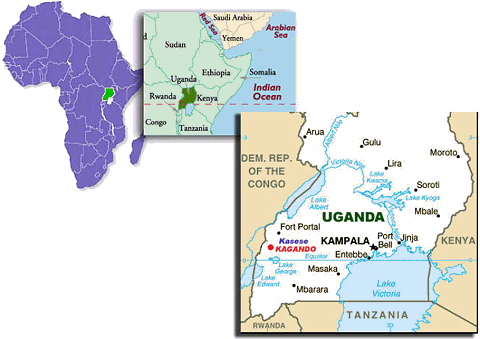
The official language of Uganda, English, is spoken as a second language by most educated Ugandans. More than 33 local languages are spoken in different parts of the country. Adult literacy rates are around 61%.
Uganda has a population of almost 20 million and an annual increase of 2.5% per annum. This rate is low by African standards, and is attributed to the internal conflict, which lasted until 1986 and the high incidence of AIDS in the country. Life expectancy is around 40. Christianity is widespread in Uganda and there are several Muslim sects.
Uganda has, by and large, a free market economy. This suffered greatly under the presidencies of Amin and Obote, but since Museveni took power in 1986 Uganda�s economy has maintained a growth rate of around 5% per annum. Agriculture accounts for about 60% of the GDP, with major export crops including coffee, tea and tobacco. Over 90% of Ugandans either are farmers or work in agriculture related fields. The currency used in Uganda is the Ugandan Shilling.
Facts about Kagando
Kagando was originally a Leprosy Settlement, set us as an isolation unit by the Ugandan government in an area chosen because of the absence of people living in the vicinity.
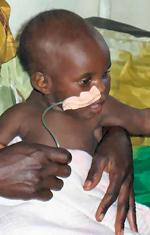 1963 the Ugandan government invited an Africa Inland Mission (AIM) missionary doctor to start a hospital in the area. The strong Christian foundation to the work of Kagando has remained throughout � the emphasis placed on Christ-like caring for patients and all those suffering.
1963 the Ugandan government invited an Africa Inland Mission (AIM) missionary doctor to start a hospital in the area. The strong Christian foundation to the work of Kagando has remained throughout � the emphasis placed on Christ-like caring for patients and all those suffering.
TEAR fund became involved in the work from early 1979 with personnel, funding and a Community Health Programme in response to a severe cholera epidemic, which killed thousands. To avoid a repeat Kagando took its maternal and child health work out into the community, training local Health Workers to provide simple health advice, with medicines, in the community.
In order to reduce the effects of erosion and to encourage tree planting, Kagando has established a tree nursery and, with Fairtrade, a honey collection unit to produce local honey. A grinding mill has been set up, which encourages and supports local farmers.
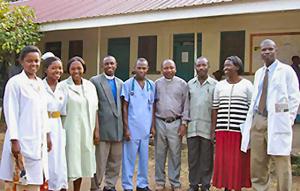 A nursery school for staff children grew into a full Primary School, which now provides a high standard of education for more than 800 children in the surrounding area.
A nursery school for staff children grew into a full Primary School, which now provides a high standard of education for more than 800 children in the surrounding area.
During the period from 1979 a new hospital was built supported by a hydro-electric scheme, based on a small river flowing out of the mountain near Kagando. AIM has capped springs on the mountainside , bringing clean water to the hospital and local communities. There were dramatic reductions in water borne disease and with new pipelines and outlets more communities now have access to clean water.
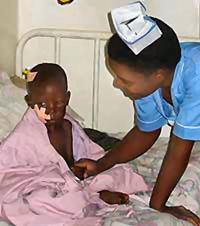 With the AIDS/HIV epidemic (which began just a short way from Kagando over the border in Congo) a huge new problem was added to the leprosy, measles, dysentery, malnutrition, tuberculosis and malaria that already ravaged the local population. To the orphans created by war there were, and are now, more, created by the problem of AIDS and its related infections. Kagando provides a Counselling and Testing Service for HIV, hostels for mothers and specific measures to try to reduce maternal/child transmission of HIV.
With the AIDS/HIV epidemic (which began just a short way from Kagando over the border in Congo) a huge new problem was added to the leprosy, measles, dysentery, malnutrition, tuberculosis and malaria that already ravaged the local population. To the orphans created by war there were, and are now, more, created by the problem of AIDS and its related infections. Kagando provides a Counselling and Testing Service for HIV, hostels for mothers and specific measures to try to reduce maternal/child transmission of HIV.
At the heart of Kagando remains a busy District General Hospital providing a full range of services for patients:
- Nurses and Midwives training
- Maternal and Child Health
- Traditional Birth Attendants
- Malaria prevention service
- Prevention of Mother to child transmission of HIV
- Counselling and Testing Service
- Palliative care
- School Health Programme
- Primary School
- Nursery School
- Foundation for Adult Literacy
- Dental Unit
- Seed bank for agriculture
- Workshops � woodwork, mechanical, panel beating
- Technical School
Challenges facing Kagando
- More doctors to work medium or long term periods
- Financial shortfall - the costs of running the project escalate constantly, and although every effort is made to contain costs, and maximise income, there is a constant need for subsidy. There is good financial management in place, with independently audited accounts.
- Threats to water and electricity supplies. The Hydro-electric power turbines and generators are now old and require upgrading and frequent repair. The water and electricity supply run alongside a road that is to e upgraded. Kagando are being asked to meet the costs of moving the pipe and cable, even though the community benefit from the supplies without cost.
- Growing work load - the needs are overwhelming
- Changing technology - With increased sophistication of treatments available, and increasing demands by the Ugandan Ministry of health to follow accepted good practice in all areas of the hospital and project mean that costs escalate.
What we can do to help
- An oxygen concentrator can be used to deliver oxygen to four different people who are having trouble breathing. We have a couple at the hospital but not enough for the demand
- Suction machines. These are basic equipment used to clear peoples� airways, often for unconscious patients or patients with no or weak cough. It is also used if someone, say, chokes on vomit etc, usually as part of the resuscitation process. It is life saving equipment.
- Saturation monitors and probes / pulse oxymeter � used to measure the amount of oxygen in the blood. It is used especially on people with chest problems, and people on oxygen and should be just a basic routine check. There are only two saturation machines in the hospital but should be on every ward. We do not have the probes that fit on peoples� fingers to take the measurements. People are being put unconscious in theatre, having an operation, with no way of checking their oxygen levels. It's very risky just relying on visual signs for respiratory distress.